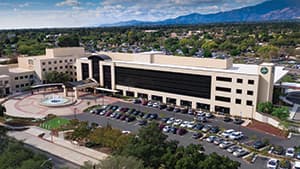Diagnostic Services
1.5 Tesla Wide Bore and 3 Tesla MRI
MRI (Magnetic Resonance Imaging) technology has been commonly used as a non-invasive medical test for diagnosing medical conditions. Most hospitals utilize 1.5T MRIs, but San Antonio offers patients 3Tesla technology and 1.5 Tesla Wide Bore, which
produces images with greater clarity and detail. Patients who experience stroke and patients undergoing brain surgeries are among the chief beneficiaries of MRI technology, but it is also used for imaging the spine, muscles, bones, joints, and
breast tissue. Wide Bore is also available for patients who may be anxious about confined spaces.
Computed Tomography (CT) Scans
CT scans, sometimes called CAT scans, are one of the diagnostic tools doctors use to reveal cancer within the body.
Using an advanced x-ray unit that rotates around your body and a powerful computer to create cross-sectional images, like slices, of the inside of your body—the CT scan clearly reveals bones and organs and their inner structure, plus a detailed
anatomy of the pancreas, adrenal glands, kidneys, and blood vessels.
A radiologist, a physician specifically trained to supervise and interpret radiology examinations, analyzes the images and sends a signed report to your primary care or referring physician, who will share the results with you.
Diagnostic Radiology (X-rays)
A radiograph or x-ray is a non-invasive medical test that helps physicians diagnose and treat medical conditions. Some of the most frequent uses of x-rays are to obtain images of bones and joints, and the chest. The images are interpreted by a radiologist
using a computer and special high-resolution monitors. The radiologist is a physician who specializes in diagnosing and treating disease and injury using medical imaging.
Mammography Screening
Our Women's Breast & Imaging Center at San Antonio Regional Hospital features digital mammography, which is an advanced type of
imaging that uses a computer, rather than x-ray film, to record x-ray images of the breast.
Diagnostic x-rays use invisible electromagnetic energy beams to produce images of internal tissues, bones, and organs on film or digital media.
Digital mammography is different from standard mammography. With digital pictures, the physician can zoom in, magnify, and optimize different parts of the breast tissue in the picture without having to take an additional image.
Endoscopic Services (GI)
San Antonio Regional Hospital's Endoscopic Services Department performs a vital function in the early detection and identification of diseases and abnormalities. The colon, esophagus, stomach, and gall bladder can all be examined and evaluated using a
videoscope or tiny camera.
During a procedure, patients are provided moderate sedation for comfort. Procedures usually take less than 30 minutes and patients are sent home shortly thereafter.
These short and simple procedures can provide an early diagnosis, which may save your life. We encourage you to talk to your physician about any specific questions or concerns that you may have. You may also call our Endoscopic Services Department weekdays,
from 6 am to 4 pm, at 909.920.4991.
Nuclear Medicine
Nuclear Medicine is a medical specialty that uses safe, painless, and cost-effective techniques to diagnose, treat, manage, and prevent serious diseases. Nuclear Medicine focuses on organ function and structure, while radiology centers on anatomy.
Nuclear Medicine imaging procedures often identify abnormalities early in the progression of a disease, long before some medical problems are apparent with other diagnostic tests. Early detection may allow for earlier treatment of the disease and increase
the potential for a more successful outcome.
We have three cameras available for imaging at San Antonio Regional Hospital: a triple headwhole body scanner, a triple head cardiac scanner, and a multi-purpose single head scanner. This equipment represents the latest technology for conducting planar
and SPECT (single photon emission computerized tomography).
Examinations are scheduled weekdays, from 7:30 am to 4:30 pm. If you have questions about your test, please contact your physician or the Nuclear Medicine Department at 909.920.4977.
Ultrasound Diagnostic
Ultrasound procedures are used to assess soft tissue structures such as muscles, blood vessels, and organs.
Ultrasound uses a transducer that sends out ultrasonic sound waves at a frequency too high to be heard. When the transducer is placed at certain locations and angles, the ultrasonic sound waves move through the skin and other body tissues to the organs
and structures within. The sound waves bounce off the organs like an echo and return to the transducer. The transducer picks up the reflected waves, which are then converted by a computer into an electronic picture of the organs or tissues under
study.

